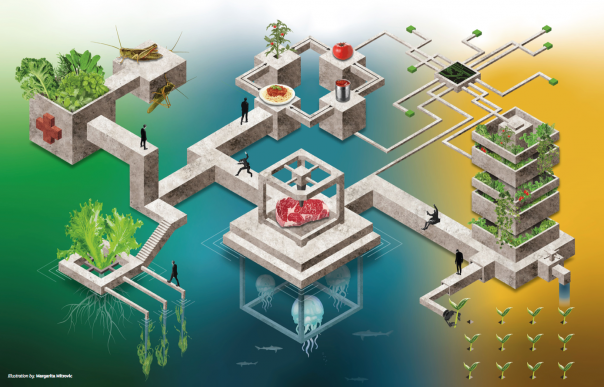
The diets of the future could include Jellyfish suppers washed down with algae milk and bread made from insect protein may eventually become the norm, while shoppers will be able to pick up ‘lab-grown’ meat kits from dedicated supermarket aisles – or even get them delivered by drone.
The report, commissioned by Sainsbury’s, with input from futurologists and plant scientists, explores what we will be eating and how food will be produced in 2025, 2050 and in 2169.
By looking at the macro trends, scientific studies and environmental awareness, it predicts that advances in technology and artificial intelligence will eventually allow diets to be personalised and give consumers the option to consume nutrients and vitamins they need through a patch or pill, or in fortified foods.
In five years time, alongside medication, doctors could be incorporating food advice as health prevention techniques to help with ailments and medical conditions.
James Wong, a plant scientist, said: “The rise in obesity and associated degenerative diseases has been driven by a complex range of factors, some of which we are only beginning to understand. However, what it has undoubtedly sparked is a growing interest in the impact diet has on health and in particular is the functional benefits food can have above and beyond their vitamin and mineral content.”
More of us – driven by unprecedented awareness of animal welfare, health concerns and eco-anxiety – will put the planet first when writing our shopping list, the report says. It notes that current foods are not sustainable for an expanding global population that is predicted to increase to 9 billion in 30 years, and more than 11 billion in the next 150 years.
Future menus will inevitably feature less meat and dairy, it says. In the shorter-term, the report predicts a quarter of Britons will be vegetarian in 2025 (up from one in eight today) and half flexitarian (up from a fifth today) who eat meat occasionally.
Paul Shapiro, author of Clean Meat, how growing meat without animals will revolutionise dinner and the world said: “It’s tough to predict 30 years into the future, but we do know this: we’re going to have to produce a lot more food with fewer resources in 2050 than we do today.
“The thought that we’ll produce meat (which is very resource-intensive) the way we do today is unrealistic. Far more likely is that we’ll be making meat from plants, as well as culturing it from animal cells. That’s not to say we won’t have any meat from slaughtered animals, but it will no longer be the dominant form of meat.”
The ‘alternative proteins’ market is predicted to swell by as much as 25% with algae milk thought to be the next plant milk to take over from nut-based versions and seaweed could be the seafood vegan plant of the future.
The report predicts that by 2169 it could be routine for people to hold details of their nutritional and health information in a personal microchip embedded in their skin, which will trigger an alert to the supermarket. It would then deliver by drone suitable food and drink based on their planned activities for the coming days.
Wong added: “For decades, diets have been simplified to include core ingredients that provided sustenance, and with that we witnessed a decline in the varieties of some ingredients. However, what we are seeing now – especially with the explosion of plant-based foods – is that diversity in food is returning to the British diet, including ancient crops like quinoa and south-east Asian staples such as jackfruit.”
In 30 years, consumers who find it hard to wean themselves off the staples of cod, salmon, haddock, tuna and prawns could be enjoying a less orthodox oceanic offering – jellyfish. Typically seen in the west as a last-resort food source, growing interest from researchers and chefs is triggering a rethink. The abundance of jellyfish due to warmer oceans and reduced predators means it may well be found in the snack aisle as crisps or as part of prepared meals.
Insects will also become mainstream, the report forecasts, and consumers will stock up on cricket flour for baking and grasshopper pasta.
With nearly two-thirds of our food derived from just four crops – wheat, maize, rice and soybean – less popular foodstuffs such as moringa, kedondong and the bambara groundnut will find their way into our cupboards.
It also looks at the next generation – Generation Aplha – who will ‘emerge into a crowded, clever and connected world of superfast digital communication, be better equipped than any other generation to tackle the problems we cannot solve today.’
They will want lifestyles with more positive social and environmental benefits, wanting to know more about where their food comes from and questioning the health implications o their diet. The rise of social media will allow consumers to share and inform one another, in turn influencing decisions and leaving brands ‘no where to hide’.
The report says: “Contrary to the dystopian future drained of humanity that is imagined by many, the combined force of personalised optimisation and farming impossible environments carve a path for how we can cut food waste, bring deserts back to life and celebrate our humanity through the act of eating. This will bring about a renaissance of planet Earth by reconnecting to our environment, and to each other.”
To read the full report, visit: https://www.about.sainsburys.co.uk/~/media/Files/S/Sainsburys/pdf-downloads/future-of-food-08.pdf